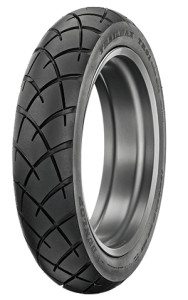One of the great things about getting older is that things I knew—or at least should have known—decades ago are now amazing new discoveries. Here’s my latest brainstorm. New, modern tires are better than old, worn-out ones.
My 2009 Suzuki DL650 V-Strom came stock with Bridgestone Trail Wings, which worked just swimmingly—stable, predictable, capable—until they started looking like racing slicks, front and rear, at about 7,000 miles.
“Great!” I thought. “Now I’ve got slicks, which will no doubt give me increasingly fabulous dry-weather traction, now that I’ve worn through that annoying ‘tread’.”
It just wasn’t working out that way. After a couple of interesting front-wheel slides, I finally realized that all that black gooey stuff I had worn away had also worn away my tires’ ability to absorb bumps and keep on sticking.
I replaced them with Dunlop Trailmax TR91s, which were introduced in 2010. These are designed for big adventure bikes, and to be capable on dirt and gravel roads as well as pavement. Which, to me, is a lovely story. I do a fair amount of gravel-road exploring on my Strom, but I am way too old and smart to be pushing these tires—or any tires—on dirt, on a 500-pound bike, out in the middle of nowhere.

On good, honest pavement, on the stock tires, my Big and Tall DL was almost too stable. It took a great heave of the bars to get through a set of esses as fast as my sportbike-riding buddies. Then I tried the TR91s.
Whole ’nother ballgame. With typical tire pressures—33 psi front, 38 psi rear—my Strom now steers like a video game. Which takes a little getting used to after four years of pulling at the bars as if I were on a rowing machine.
The new TR91s also ride as smooth as a foamed runway. They have great shock absorption and damping properties—they seem to flow rather than roll—which turn crumpled roads that used to feel like work into paid days off. This may have something to do with Dunlop’s Jointless Belt technology—which sounds like a shotglass drink in a pot-free Denver bar, but which apparently allows Dunlop’s designers to add compliance without compromising grip or wear.
Dry-pavement traction is at least as good as the stockers, back when they were new, and I seem to be dragging my footpegs more than I used to, though this may be a function of the lighter steering getting me leaned over farther and sooner than before.
The only caveat is that once set into a corner, the Trailmaxes will still change direction with minimal effort. I find myself having to consciously relax at the bars to keep my lines as smooth as they used to be. Will I change my bike’s stance (fork tubes down, front preload up?) to compensate? Nah. I have a feeling that if I just go riding, instead of sitting in my garage screwing around with my bike, I’ll wind up miles ahead.
For more information, see your dealer or visit dunlopmotorcycle.com.
(This Gearlab review was published in the March 2014 issue of Rider magazine.)








Pulling on the bars?? You should be pushing on them my friend.